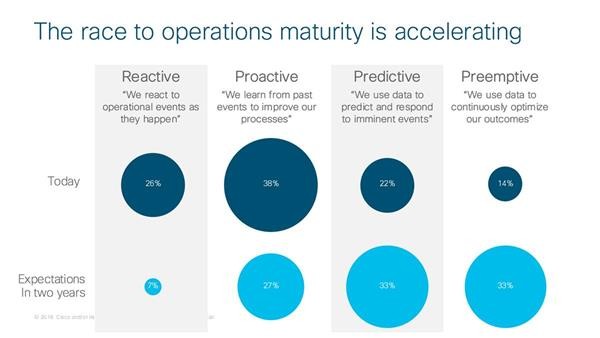Joseph Bradley, Cisco’s Global Vice President, IoT, Blockchain, AI, and Incubation Business says: “Gone are the days of IT leaders relying on past monthly reports and hours upon hours of manual operational tasks to deliver results in the face of growing infrastructure complexity. Instead, fueled by data and empowered by automation, IT can operate in real-time, be predictive, and rely on detailed data to have a true seat at the table, delivering strategic value for their organization and for their customers.”
Introducing the IT Operations Readiness Index
Today IT spends around 78 percent of their budgets simply “running the business” which leaves little room for innovation. However, there’s a way to reallocate budgets to prioritize transformational activities with some organizations already progressing along the IT operations maturity model.
First, it’s important for IT to understand where organizations are on the four-step maturity model and where they would like to be in two years.
Organizations at higher levels of maturity reported collecting data from more areas of their infrastructure, running more analytics and using automation more extensively. To get “preemptive” capabilities, organizations must be more data-driven by utilizing data indicators to predict events (such as, outages) and automation to make continuous changes and maintain optimal health.
“As organizations advance along the model, they use data to look further into the future,” says Joseph Bradley. “Through analytics and automation, CIOs can evolve from blindly reacting to events—such as outages—to continuously monitoring and optimizing their infrastructures based on predictions of future needs. As a result, they can deliver strategic outcomes for their business partners, with change moving from being surprising and threatening to becoming something to control.”
IT Operations Readiness Index Key Findings:
Operations has become a strategic focus for business success
- 28 percent of survey respondents’ IT budgets are spent optimizing and remediating IT operations. 68 percent of respondents expected to increase that budget over the next 12 months.
- 40 percent of respondents said they already rely “heavily” on IT operational data for business decision-making.
Investing in operations drives customer benefits and value to the business
- 88 percent of IT leaders said their investment in IT operations over the past 12 months had improved external customer satisfaction and 89 percent noted improvements in innovation.
The race to a preemptive model is just the beginning
- Only 14 percent have reached the highest level of IT operations capabilities, which we call “preemptive.” 26 percent are still at the lowest level, where IT events are reacted to as they occur (“reactive” operations). Yet 33 percent expect to have reached preemptive operations within two years.
- The most advanced, those with “preemptive” operational capabilities, are twice as likely to perform continuous automation than the least advanced organizations, and more than 50 percent more likely to perform organization-wide automated data collection.
- Only 26 percent collect data on an ongoing basis; 17 percent use real-time automated analysis. Most activities are still periodic.
AI + Talent = Success
- 42 percent said AI was the emerging technology that will have the biggest impact on their ability to automate. 51 percent said they use AI to some extent today to improve their automation capability.
- 70 percent of enterprises currently have a Chief Data Officer, a role critical to orchestrating the use of insight to drive improvement in both business and IT operations. Enterprises employed on average more than 40 data scientists.
Outside vendors are critical sources of data
- 84 percent said it’s “imperative” to have access to data beyond what is collected internally. The most advanced organizations already use outside vendors for more operational activities (e.g. data aggregation); vendors will become a key source of data, too.
Security is the most data-driven of the infrastructures
- 82 percent of respondents already collect operational and performance data about their security infrastructure, the highest of any area of IT. Security is the clearest use case for getting real-time insight and control, and the “tip of the spear” for investing in data-driven operations.
IoT is the connection from IT to the business edge
- 74 percent of “preemptive” organizations gathered data from IoT today versus 59 percent of “reactive” organizations. 77 percent of all organizations agreed that IoT was critical to running their IT infrastructure more efficiently.
When IT operations has the right data, the right insights mined from that data, and the ability to automate operational tasks across the infrastructure, they have the opportunity to differentiate themselves. It’s now time for CIO’s to focus on the innovation side of IT operations.
As Zeus Kerravala of ZK Research said, “In the future, the most successful companies are the ones that have the best quality data, AI algorithms to interpret it and a CDO to ensure quality and consistency.”




